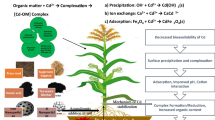Abstract
It is common to find that low bioavailability can prevent the phytoremediation process of heavy metal-contaminated soils. Heavy metals in soil are associated with various forms having different bioavailability. In this study, the bioavailability of various Cu forms in contaminated soils was investigated using ion-exchange resins, a sequential extraction procedure, and combined with methods including partial dissolution procedure, simulated Cu forms, seedling culture, pot experiment when treated with EDTA, or waste water from monosodium glutamate and citric acid production. Results showed that the bioavailability, in decreasing order of different Cu forms to tall fescue (Festuca arundinacea Schreb.) is: exchangeable Cu (EX-Cu) and organic matter bound Cu (OM-Cu)> Cu bound to carbonate (CAB-Cu)> Fe/Mn oxide bound Cu (OX-Cu)> residual Cu (RES-Cu). Effect of EDTA on the activation of Cu contaminated soil or simulated Cu and the uptake and translocation of tall fescue was better than that of monosodium glutamate waste water (MGW) and citric acid waste water (CAW). EDTA, CAW and MGW all improved the plant availability of different Cu forms in contaminated soil, which could be used in chelate-assisted phytoremediation of heavy metal polluted soil.
Similar content being viewed by others
References
Alva A K, Graham J H and Tucker D P H 1993 Role of calcium in amelioration of copper phytotoxicity for citrus. Soil Sci. 155, 211–218.
Balistrieri L S and Murray J W 1983 Metal-solid interactions in the marine environment: estimating apparent equilibrium binding constants. Geochim. Cosmochim Acta 47, 1091–1098.
Blaylock M J 2000 Field demonstrations of phytoremediation of lead-contaminated soils. <nt>In</nt> Phytoremediation of Contaminated Soil and Water. <nt>Eds</nt>. N. Terry and G. Banuelos. pp. 1–12. CRC Press, Boca Raton FL.
Blaylock M J, Salt D E, Dushenkov S, Zakharova O, Gussman C, Kapulnik Y and Enslay B D 1997 Enhanced accumulation of Pb in Indian mustard by soil applied chelation agents. Environ. Sci. Tech. 31(3), 860–865.
Brun L A, Maillet J, Richarte J, Herrmann P and Remy J C 1998 Relationships between extractable copper, soil properties and copper uptake by wild plants in vineyard soils. Environ. Pollut. 102, 151–161.
Brun L A, Maillet J, Hinsinger P and Peâpin M 2001 Evaluation of copper availability to plants in copper-contaminated vineyard soils. Environ. Pollut. 111, 293–302.
Esnaola M V and Millan E 1998 Evaluation of heavy metal lability in polluted soils by a cation exchange batch procedure. Environ. Pollut. 99, 79–86.
Gadde R R and Laitinen H A 1974 Studies of heavy metal adsorption by hydrous iron and manganese oxides. Analy. Chem. 46(13), 2022–2026.
Garbisu C and Alkorta I 2001 Phytoextraction: a cost-effective plant-based technology for the removal of metals from the environment. Bioresource Technol. 77, 229–236.
Grzebisz W, Kocialkowski W Z and Chudzinski B 1997 Copper geochemistry and availability in cultivated soils contaminated by a copper smelter. J. Geochem. Exploration 58, 301–307.
He H P, Guo J G, Xie X D and Peng J L 2001 Location and migration of cations in Cu2+-adsorbed montmorillonite. Environ. Int. 26, 347–352.
Huang JW, Chen J J, Berti WR and Cunningham S D 1997 Phytoremediation of lead-contaminated soils: role of synthetic chelates in lead phytoextraction. Environ. Sci. Technol. 31, 800–805.
Juste C 1988 Appreciation de la mobilité et de la biodisponibilité des éléments en traces du sol. Sci. Sol 26, 103–112.
Lebourg A and Sterckeman T 1996 Intérêt de différents réactifs d'extraction chimique pour l'évaluation de la biodisponibilité des métaux en traces du sol. Agronomie 16, 201–215.
MAPA (Ministerio de Agricultura,Pesca y Alimentación) 1986 Métodos oficiales de análiswas de suelos,agues y plantas. Tomo [I]. Ministerio de Agricultura, Pesca y Alimentación, Servicio de Publicaciones, Madrid. pp. 93–161.
Marschner H (Ed.) 1995 Mineral Nutrition of Higher Plants, 2nd Edition. Academic Press, London.
McBride M B 1976 Origin and position of exchange sites in kaolinite: an ESR study. Clays Clay Miner. 24, 88–92.
Norvell WA 1984 Comparison of chelating agents as extractants for metals in diverse soil materials. Soil Sci. Soc. Am. J. 48, 1285–1292.
Raskin I, Smith R D and Salt D E 1997 Phytoremediation of metals: using plants to remove pollutants from the environment. Curr. Opin. Biotechnol. 8, 221–226.
Salim R 1983 Adsorption of lead on the suspended particles of river water. Water Res. 17, 423–429.
Salt D E, Blaylock M, Kumar P B A N, Dushenkov V, Ensley B D, Chet L and Raskin L 1995 Phytoremediation: a novel strategy for the removal of toxic metals from the environment using plants. Biotechnology 13, 468–474.
Sauve S, McBride M B, Norvell W and Hendershot W H 1997 Copper solubility and speciation of in situ contaminated soils: Effects of copper level, pH and organic matter. Water Air Soil Pollut. 100, 132–149.
Singh S P and Rakipov N G 1988 Effects of Cd, Cu, and Ni on barley, and their removal from the soil. Int. J. Environ. Stud. 31, 291–295.
Suraj G, Iyer C S P and Lalithambika M 1998 Adsorption of cadmium and copper by modified kaolinites. Appl. Clay Sci. 13, 293–306.
Tessier A, Campbell P G C and Bisson M1979 Sequential extraction procedure for the speciation of particulate trace metals. Anal. Chem. 51, 844–851.
Tu C 1997 Bioavailability of Ni fraction in soils. Acta Sci. Circumstantiae 17(2), 179–186.
Wu J, West L J and Stewart D I 2001 Copper(?) humate mobility in kaolinite soil. Eng. Geol. 60, 275–284.
Xian X 1989 Effect if chemical of cadmium, zinc, and lead in polluted soils on their uptake by cabbage plants. Plant Soil 113, 257–264.
Rights and permissions
About this article
Cite this article
Chen, Y., Shi, J., Zhang, W. et al. EDTA and industrial waste water improving the bioavailability of different Cu forms in contaminated soil. Plant and Soil 261, 117–125 (2004). https://doi.org/10.1023/B:PLSO.0000035564.43591.20
Issue Date:
DOI: https://doi.org/10.1023/B:PLSO.0000035564.43591.20




